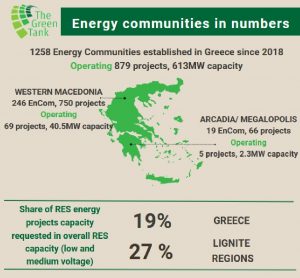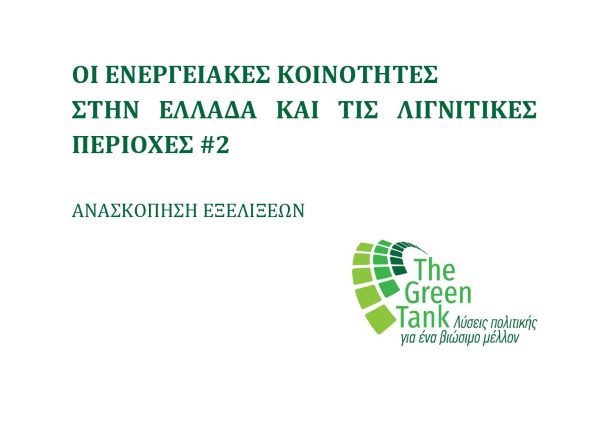The energy crisis has brought to the fore how Renewable Energy Sources (RES) enable citizens not only to address energy poverty but also to meet their own energy needs, as self-producers, both individually and collectively. In the review titled “Energy Communities in Greece and in its lignite areas”, The Green Tank presents developments on energy communities in Greece over the last six months, with a particular focus on lignite regions, following the first review of developments published in November 2021.
Based on official data by the General Commercial Registry (GEMI) and the Hellenic Electricity Distribution Network Operator (HEDNO), the review presents the current status of Energy Communities both in low and medium voltage and those covering own electricity needs using virtual net metering. Then, the review provides a critical assessment of the institutional and financial developments of the last six months. It also outlines the key challenges regarding the further development of Energy Communities and concludes with recommendations to strengthen the institution, especially in the context of Just Transition.
 The main findings of the analysis can be summarized as follows:
The main findings of the analysis can be summarized as follows:
- Interest in the development of energy communities remains high in Greece as well as in the lignite areas of the country. In particular, as of May 2022, 1,258 active energy communities were recorded in the territory, 222 more than the corresponding record in November 2021. Of those, 246 are located in Western Macedonia (the second region in Greece in terms of number of energy communities after Central Macedonia) and 19 in Arcadia only two of which are established in the lignite region of Megalopolis.
- However, issues of grid availability for projects by energy communities and obstacles of bureaucracy result in low electrification rate, significantly restricting citizens’ potential to participate in the energy transition. Specifically, as of May 2022 data on low and medium voltage and net metering cumulatively show that there are 4,820 pending requests for such projects with a total capacity of 3,886.8 MW, while only 884 projects with a capacity of 614,15 MW have been electrified nationwide.
- The vast majority of the electrified projects are on the low and medium voltage network where the energy produced is sold to the grid (613 MW out of 879 projects), while there are only 5 electrified projects that use the virtual net metering to cover own needs with a total capacity of 1.15 MW (0.03 MW in Western Macedonia). Therefore, the institutional framework of energy communities has so far been used primarily to make a profit from the sale of electricity and not to meet own electricity needs.
- However, at the same time, connection requests for virtual net metering projects by energy communities at the national level are on the rise (89% compared to November 2021), while Western Macedonia records notable dynamics with 14 new requests (+55.5% compared to November 2021).
“Energy communities can play a key role in addressing the energy crisis, supporting households that opt for collective self-production of electricity. The growing interest of citizens in creating energy communities and using virtual net metering to meet their own needs brings to the fore the necessity for grid upgrades, reserving grid space for energy communities, but also providing greater support to these efforts, both institutionally and financially”, noted Ioanna Theodosiou, Policy Associate at The Green Tank.
The full review of developments on “Energy Communities in Greece and in its lignite areas” is available here.
* The announcement of the Review was updated on 20/09/2022.



